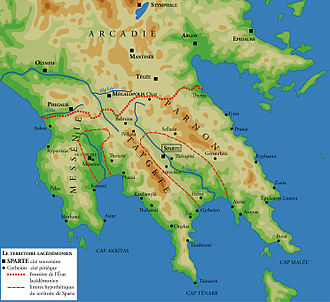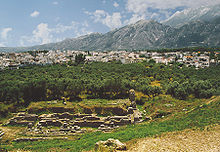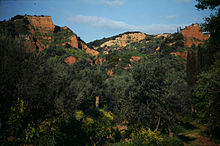Sparta
![]()
This article is about the ancient society and city of Sparta. For the modern municipality, see Sparta (municipality). For other meanings, see Sparta (disambiguation).
Sparta, located in the south of the Peloponnese, was in ancient times the capital of the countryside Laconia and the state of the Lacedaimonians. Its name is usually used in German in an extended sense for this state, which for centuries was the strongest military power of ancient Greece. Although called a polis, Sparta differed in many ways from other Greek city-states, most notably Athens.
Sparta's power was based on a unique state and social order that was more militaristic than in most ancient polities. Since Aristotle, it has often been described as a hybrid of democracy, oligarchy, and monarchy, although the oligarchic-aristocratic elements predominated. Political participation in Sparta was reserved for only a small minority of full citizens, the Spartiates. These were provided for economically by the oppressed Helots, who constituted by far the largest part of the population. A third group were the personally free but politically lawless Periaeans. Greatly simplified, these structures are often portrayed as the antithesis of Attic democracy, which guaranteed political equality as citizens to a much larger proportion of the population. Also characteristic of Sparta was the dual kingship. According to Aristotle, however, this was rather a hereditary office of general, the holders of which had hardly any monarchical powers.
As elite fighters, the Spartans formed the backbone of the Spartan army. Their military strength enabled Sparta for a long time to exert great influence on the fate of the whole of Greece. Thus, it played a prominent role in the Persian Wars and emerged victorious from the Peloponnesian War against Athens in 404 BC. However, Sparta did not succeed in maintaining the hegemonic position it had now won over a longer period of time. At the latest after the defeat against Thebes in the battle of Leuktra in 371 BC, it lost this position again. In the following 200 years Sparta tried in vain to regain its supremacy at least in the Peloponnese. In the 2nd century BC, like all Greek states, it came under Roman rule, but nominally maintained its status as a free city until the 3rd century AD.
A peculiarity of Spartan history is that there are no written sources from the hand of Lacedaimonians themselves. As a result, the image of Sparta was shaped by often hostile contemporaries from other poleis or by sometimes romanticizing historians of later times. To this day, mythicizing and idealizing representations make a realistic reconstruction of Sparta's history difficult.

Territory of ancient Sparta
Geography
The city area was situated on the eastern foothills of the Taygetos Mountains, close to the right bank of the river Eurotas and was no longer populated in the Middle Ages. A new foundation took place in 1834, see Sparta (municipality).
On both sides of the river Eurotas stretches a fertile plain flanked by two mountain ranges, Taygetos to the west and Parnon to the east. In this river basin Sparta grew out of a few villages. The location of Sparta offered a natural protection by the mountains which surrounded the river valley. However, only a small area of about 500 km² could be used for agriculture.
The city consisted of four spacious, garden-rich quarters, which together had a circumference of about nine kilometers. Unlike Athens, Sparta did not commune its conquered territories, which is why the Spartan population remained relatively small compared to Athens. It is estimated that in 600 B.C. there were about 40,000 to 50,000 people living in the city itself.

The excavated amphitheatre of ancient Sparta, the modern city in the Evrotas Valley and the Taygetos

Landscape near Sparta
Cityscape
Until Hellenistic times, the city had no continuous walls, as the feared army was able to keep all enemies away; only the tyrant Nabis laid a ring of walls, which, although soon destroyed by the Achaians, was restored by order of the Romans and renewed as late as early Byzantine times. Of the individual quarters (Komen) Pitana in the northeast is mentioned as the most beautiful. Here was the Agora with the assembly buildings of the Gerusia and the Ephors, the Persian Hall built by the Persian spoils, and in Roman times the great white marble-clad theatre, of which some remains still survive.
Sparta did not have a high acropolis. This name was given to the hill of the city, on the top of which stood the temple of Athena Chalkioikos, the city deity of Sparta. The city had, besides those mentioned, numerous other temples and monuments which Pausanias mentions, the location of some of which can still be traced today. Remains of Roman baths are to the north-west and south-east of the theatre, and remains of an ancient bridge over the Eurotas on the present road to Argos and Tegea. Other squares were located to the west of the city: on the road to Messene were the Dromos with two gymnasia and the Platanistas square, planted with plane trees, where the young men used to wrestle.
The construction of the mountain fortress and residential city of Mystras to its west led to the desolation of the ancient city.
Questions and Answers
Q: What is Sparta?
A: Sparta is a Greek city-state that was extremely powerful during antiquity.
Q: Where is Sparta located?
A: Sparta is located in the south of Peloponnese peninsula and is the capital of the Laconia prefecture.
Q: How many people lived in Sparta according to the 2001 census?
A: According to the 2001 census, 16,726 people lived in Sparta.
Q: What is the meaning of the word Spartan?
A: The word Spartan is used to describe somebody who lives a simple life or somebody who suffered a lot without crying or showing that they suffered. It can also mean a life of simplicity, without anything fancy or costly.
Q: Where is the ancient Sparta built?
A: Ancient Sparta was built on the banks of the Evrotas River.
Q: What are the natural defenses of Sparta?
A: The ancient Spartans had such good natural defenses because they were in a mountainous region of Laconia. The region is sandwiched between the Taygetus Range to the west and the Parnon Range to the east. As a result, they did not need city walls.
Q: What is Sparta known as?
A: Sparta is also known as Lacedaemon.
Search within the encyclopedia